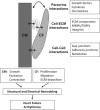Cross talk between cardiac myocytes and fibroblasts: from multiscale investigative approaches to mechanisms and functional consequences
- PMID: 23064834
- PMCID: PMC3532535
- DOI: 10.1152/ajpheart.01167.2011
Cross talk between cardiac myocytes and fibroblasts: from multiscale investigative approaches to mechanisms and functional consequences
Abstract
The heart is comprised of a syncytium of cardiac myocytes (CM) and surrounding nonmyocytes, the majority of which are cardiac fibroblasts (CF). CM and CF are highly interspersed in the myocardium with one CM being surrounded by one or more CF. Bidirectional cross talk between CM and CF plays important roles in determining cardiac mechanical and electrical function in both normal and diseased hearts. Genetically engineered animal models and in vitro studies have provided evidence that CM and CF can regulate each other's function. Their cross talk contributes to structural and electrical remodeling in both atria and ventricles and appears to be involved in the pathogenesis of various heart diseases that lead to heart failure and arrhythmia disorders. Mechanisms of CM-CF cross talk, which are not yet fully understood, include release of paracrine factors, direct cell-cell interactions via gap junctions and potentially adherens junctions and nanotubes, and cell interactions with the extracellular matrix. In this article, we provide an overview of the existing multiscale experimental and computational approaches for the investigation of cross talk between CM and CF and review recent progress in our understanding of the functional consequences and underlying mechanisms. Targeting cross talk between CM and CF could potentially be used therapeutically for the modulation of the cardiac remodeling response in the diseased heart and may lead to new strategies for the treatment of heart failure or rhythm disturbances.
Figures


References
-
- Adler CP, Ringlage WP, Bohm N. [DNA content and cell number in heart and liver of children. Comparable biochemical, cytophotometric and histological investigations (author's translation)]. Pathol Res Pract 172: 25–41, 1981 - PubMed
-
- Asazuma-Nakamura Y, Dai P, Harada Y, Jiang Y, Hamaoka K, Takamatsu T. Cx43 contributes to TGF-β signaling to regulate differentiation of cardiac fibroblasts into myofibroblasts. Exp Cell Res 315: 1190–1199, 2009 - PubMed
-
- Askar SF, Bingen BO, Swildens J, Ypey DL, van der Laarse A, Atsma DE, Zeppenfeld K, Schalij MJ, de Vries AA, Pijnappels DA. Connexin43 silencing in myofibroblasts prevents arrhythmias in myocardial cultures: role of maximal diastolic potential. Cardiovasc Res 93: 434–444, 2012 - PubMed
Publication types
MeSH terms
Grants and funding
LinkOut - more resources
Full Text Sources
Other Literature Sources
Miscellaneous

